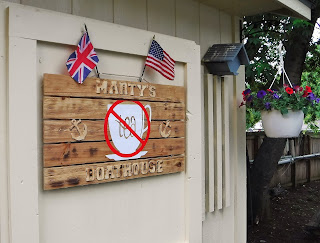We Call Her "She"

When I kayak-camped Old Hickory Lake in the fall of 2016, I learned that a broader view of my "ordinary life" created a matching horizon and that every adventure whether great or small sharpens a dull perspective.
Buying the Catalina 25' was a precarious risk, but the benefits are already self-evident. My shed was a dump, my tools unrecognizable. Now, electricity, a coffee pot, beer fridge, roll-away tool-chest and wireless internet access embolden my determination. I created a space for design drawings and then built an inexpensive workbench from lumber costing less than fifty dollars.
Buying the Catalina 25' was a precarious risk, but the benefits are already self-evident. My shed was a dump, my tools unrecognizable. Now, electricity, a coffee pot, beer fridge, roll-away tool-chest and wireless internet access embolden my determination. I created a space for design drawings and then built an inexpensive workbench from lumber costing less than fifty dollars.
The Catalina’s previous owner had abandoned an assortment of useful and expensive accessories, including the additional winches and running-rigging for single-handed sailing. I calculated the “used” or “second-hand” value of the equipment stowed in the sailboat’s cabin, along with the tandem-axle trailer. The exercise encouraged my optimism. I valued the property at more than double the price paid, and that excluded the value of the boat.
However,
elation soon gave way to suspicion. Why did I get such a good deal? Did I
overlook a potentially catastrophic fault as I carried out the preliminary
inspection? After all, I studied Don Casey’s “Inspecting the Aging Sailboat.” What did I miss? What did the
previous owner hide from me? I thought, noticing the shadow of a doubt. Believing
I had mastered the art of the deal as an accomplished boat-buyer, the discovery
of a costly repair would seriously mash my pride.
Nevertheless, my growing attachment to the boat ensured that my dreams remained intact. Not long after the Catalina’s arrival, I began using the feminine pronoun. I referred to the boat as “she” or “her,” a historical tradition for seamen yet without, so far anyway, a reasonable explanation. Rear Admiral Francis D. Foley’s satirical prose “Why We Call a Ship a She,” records how a “salty retiredU.S.
Nevertheless, my growing attachment to the boat ensured that my dreams remained intact. Not long after the Catalina’s arrival, I began using the feminine pronoun. I referred to the boat as “she” or “her,” a historical tradition for seamen yet without, so far anyway, a reasonable explanation. Rear Admiral Francis D. Foley’s satirical prose “Why We Call a Ship a She,” records how a “salty retired
Female or not, my relationship began with the Catalina 25 the minute I first laid eyes on her. In the days that followed her moving into my home, my infatuation only grew. I love her I thought as she towered above me, the tip of her bow nosed up in the air, her red and green side lights squinting from the hull. She drew my full attention. Boy, I couldn’t wait to climb into her cockpit and stake my claim as her captain.
The dreamboat honeymoon lasted for weeks, but soon after, lovey-dovey gave way to practicality. The exact nature of our relationship clarified as I scrutinized her physical condition.
I stripped her down and took photographs. I considered her past, her excellent reputation as I picked at her many blemishes. “Who could have done this to you?” I asked and finally deduced that for several years others had mistreated her. Used and abused, my Catalina 25 bore the scars of macho neglect. “She” is the worn out residue of her previous relationships. I desperately wanted to fix her, a scenario I frequently encountered during my twenties and thirties.
Without a doubt, renovating a sailboat is an enormous commitment that emulates a human connection. This similarity supported my use of the feminine personal pronoun. For me, fixing up this Catalina 25 is indeed a romantic adventure, and so she deserves the highest esteem. As promised, I posted a gallery of pictures for you on my website, martinjlaight.com Visit the site or click here on "Catalina 25 pics."
Finally, for an elaborate carpentry tutorial, I recommend a visit to YouTube where an increasing number of master craftsmen inspire humanity for zero dollars down, usurping traditional education methods. Click the following link and discover “my dream workbench” posted by KingPost TimberWorks.




Comments
Post a Comment
I want my blog to be helpful to you. if you have any questions or wish to share your experience in the field of sailboat renovation, I appreciate your insightful comments.